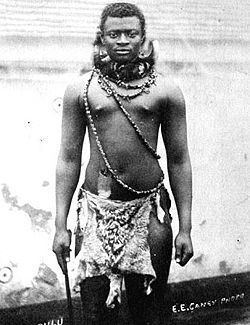Spouse None Children Solomon kaDinuzulu Parents Cetshwayo kaMpande | Name Dinuzulu kaCetshwayo | |
 | ||
Reign 20 May 1884 – 18 October 1913 Died October 18, 1913, Transvaal Province Grandchildren Cyprian Bhekuzulu kaSolomon Similar People Cetshwayo kaMpande, Solomon kaDinuzulu, Mpande kaSenzangakhona | ||
Grandparents Mpande kaSenzangakhona | ||
Dinuzulu kaCetshwayo (1868 – 18 October 1913, commonly misspelled Dinizulu) was the king of the Zulu nation from 20 May 1884 until his death in 1913. He succeeded his father Cetshwayo, who was the last king of the Zulus to be officially recognized as such by the British. Zululand had been broken up into 13 smaller territories by the British after the Anglo-Zulu War, and Cetshwayo, and subsequently Dinuzulu, administered one of them. The British later realized the futility of breaking up Zululand into the territories and restored Cetshwayo as paramount leader of the territories. However, they left one of Cetshwayo's sons, Usibepu (Zibhebhu), alone with his lands intact. On 22 July 1883, Usibepu attacked Cetshwayo's new kraal in Ulundi, wounding the king and causing him to flee.
Contents
Dinuzulu's volunteers
To contest the succession, Dinuzulu first appealed to the British, but had no response. He then offered rewards of land to Boer farmers of the Vryheid and Utrecht districts, to come and fight on his side and restore the Zulu Kingdom. In 1884 a group of Boer farmers from the districts of Utrecht and Vryheid undertook to help restore order, in return for land for the formation of an independent republic with access to the sea. Led by General Louis Botha, they formed Dinuzulu's Volunteers and after several clashes with Zibhebhu, defeated him at the Battle of Ghost Mountain (also known as the Battle of Tshaneni) on 5 June 1884.
The Nieuwe Republiek, established in northern Natal on land awarded to Boers by Dinuzulu, was recognized by Germany and Portugal. It was later incorporated on its request by the ZAR because of financial problems, after the British annexed the coastal plains from the Thuhela river (Tugela) northwards in order to prevent the Boers from building a harbor. After considerable dispute in a Natal arbitration court, Britain eventually recognized the New Republic, but reduced in size after annexation of the coastal plains by Britain and deprived of its claims to St Lucia for a harbor. The Niewe Republiek was incorporated on its own request with the Zuid Afrikaanse Republiek in 1888. Stability in the Zulu kingdom continued until the British annexed the Zuid Afrikaanse Republiek in 1899.
Exile
In 1890 Dinuzulu was captured by the British and exiled to the island of Saint Helena for seven years, for leading a Zulu army against the British due to annexation of the coastal plains of Zululand.
Bambatha rebellion
In 1906 the so-called Bambatha rebellion broke out. After the rebellion had been put down, Dinuzulu was accused of giving orders to Bambatha to start the rebellion and was put on trial for treason. Although he steadfastly protested his innocence, he was found guilty and sentenced to four years imprisonment in March, 1908.
Two years later an old friend of his, General Louis Botha, became Prime Minister of the Union of South Africa. Botha ordered that Dinuzulu be released and transported to the farm Uitkyk in the Transvaal, where he died in 1913 at the age of 44 or 45.
He was succeeded by his son Solomon kaDinuzulu.
Statue
A statue of Dinuzulu has been erected next to the statue of General Louis Botha, the first prime minister of the Transvaal colony, at the corner of Berea Road and Warwick Avenue in Durban.
Wood Badge beads
Beads from Dinuzulu's necklace—claimed to have been found by Robert Baden-Powell—were later presented to Scout leaders following Wood Badge leadership training. Today the Wood Badge beads are replicas of the original beads.
